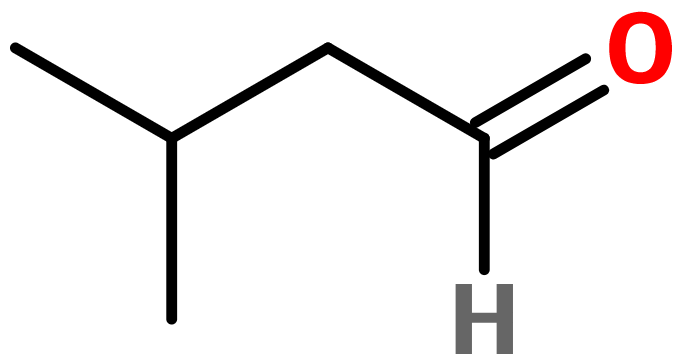
Photo credits: ScenTree SAS
Isovaleraldehyde
Isoamyl aldehyde ; 3-methylbutanal ; 3-methyl butanal ; 3-methylbutan-1-al ; 3-methyl butan-1-al ; 3-methyl butyraldehyde ; 3-methyl-1-butanal ; Isopentaldehyde ; Isovaleral ; Isovaleric aldehyde

Photo credits: ScenTree SAS
Do you sell any of the raw materials? Would you like to let our users know?
Send an email to fournisseurs@scentree.coto learn about our advertising opportunities.
Do you sell any of the raw materials? Would you like to let our users know?
Send an email to fournisseurs@scentree.coto learn about our advertising opportunities.
General Presentation
-
CAS N° : 590-86-3
-
EINECS number : 209-691-5
-
FEMA number : 2692
-
FLAVIS number : 05.006
-
JECFA number : 258
-
Appearance : Colorless liquid
-
Density : 0,803
-
Volatility : Head
-
Price Range : Data not available.
Physico-chemical properties
-
Molecular formula : C5H10O
-
Molecular Weight : 86,13 g/mol
-
Log P : 1,5
-
Fusion Point : -51°C
-
Boiling Point : 90°C
-
Detection Threshold : Donnée indisponible.
-
Optical rotation : Donnée indisponible
-
Vapor pressure : Donnée indisponible
-
Refractive Index @20°C : Donnée indisponible
-
Acid Value : Donnée indisponible.
-
Flash Point : 0,5°C
Uses
Uses in perfumery :
Isovaleraldehyde is used in cherry and chocolate notes, to bring a liquorous head note.
Year of discovery :
Data not available.
Natural availability :
Isovaleraldehyde is found in the odorous principle of many fruits and food we consume every day : apple, ginger, beef, lovage…
Isomerism :
Isovaleraldehyde does not have any isomer used in perfumery.
Synthesis precursor :
Isovaleraldehyde can be used to synthesize Schiff bases, reacting with Methyl Anthranilate or Indole for example.
Synthesis route :
Isovaleraldehyde is synthesized by oxydation of Isoamyl Alcohol.
Regulations & IFRA
Allergens :
This ingredient does not contain any allergen.
IFRA 51th :
This ingredient is not restricted for the 51th amendment


